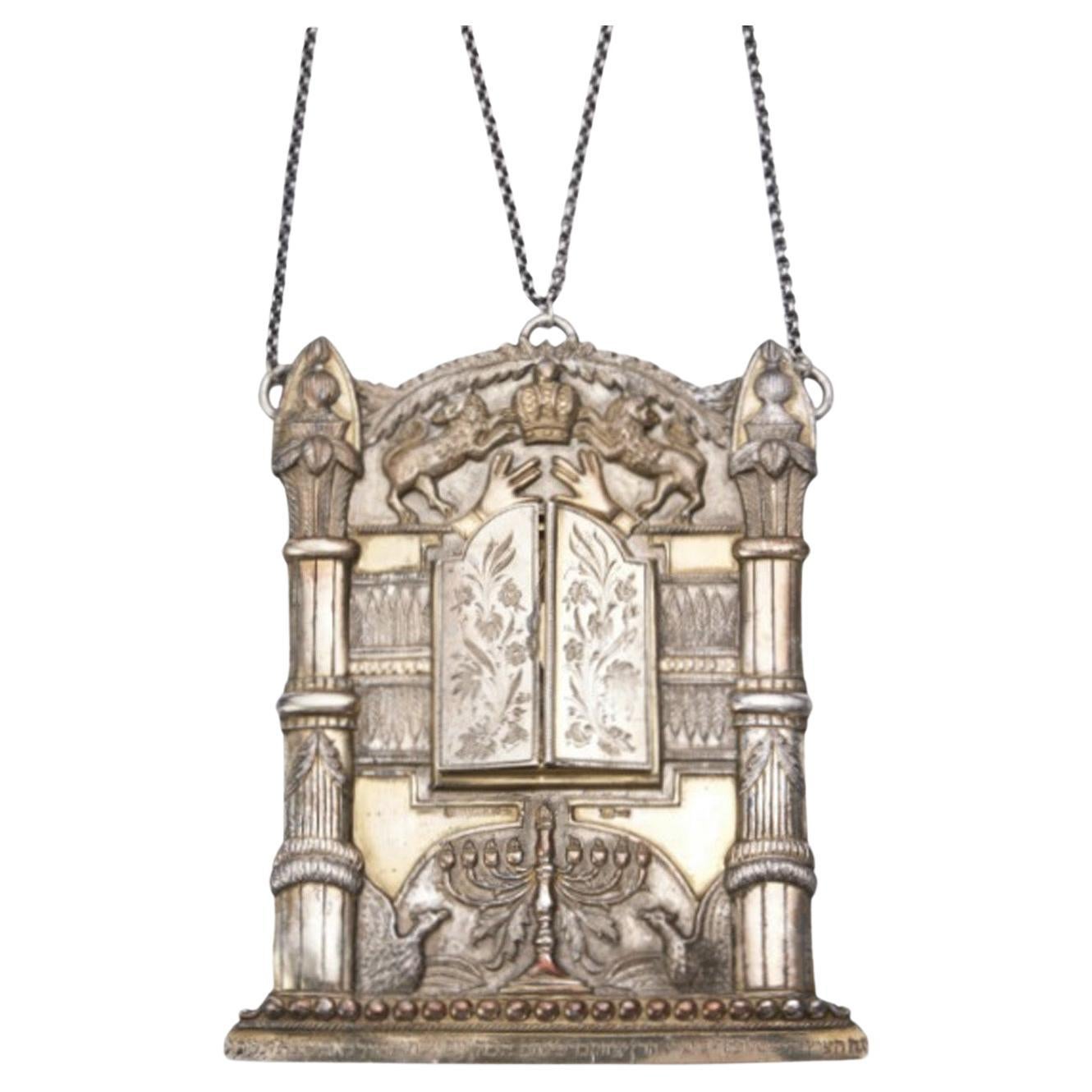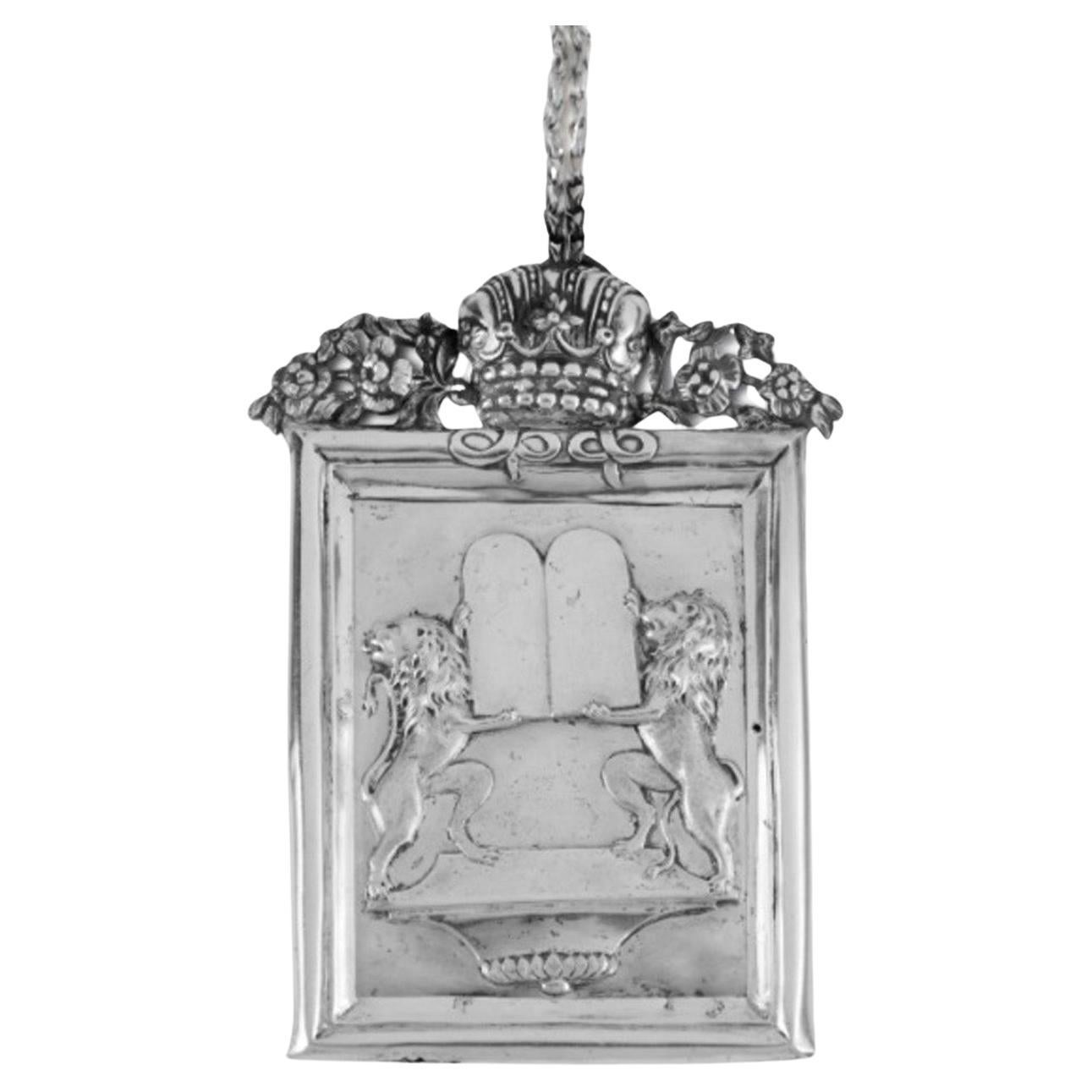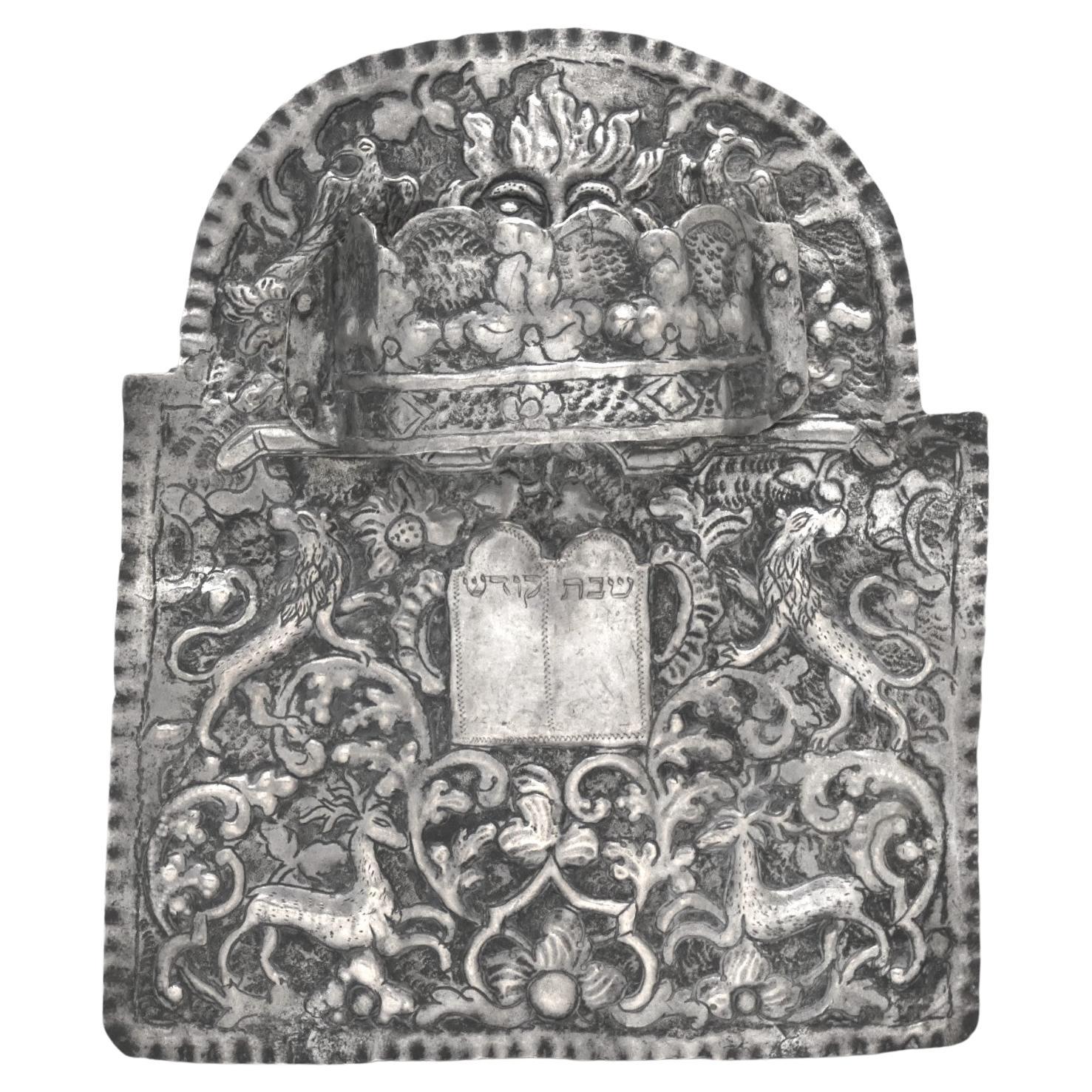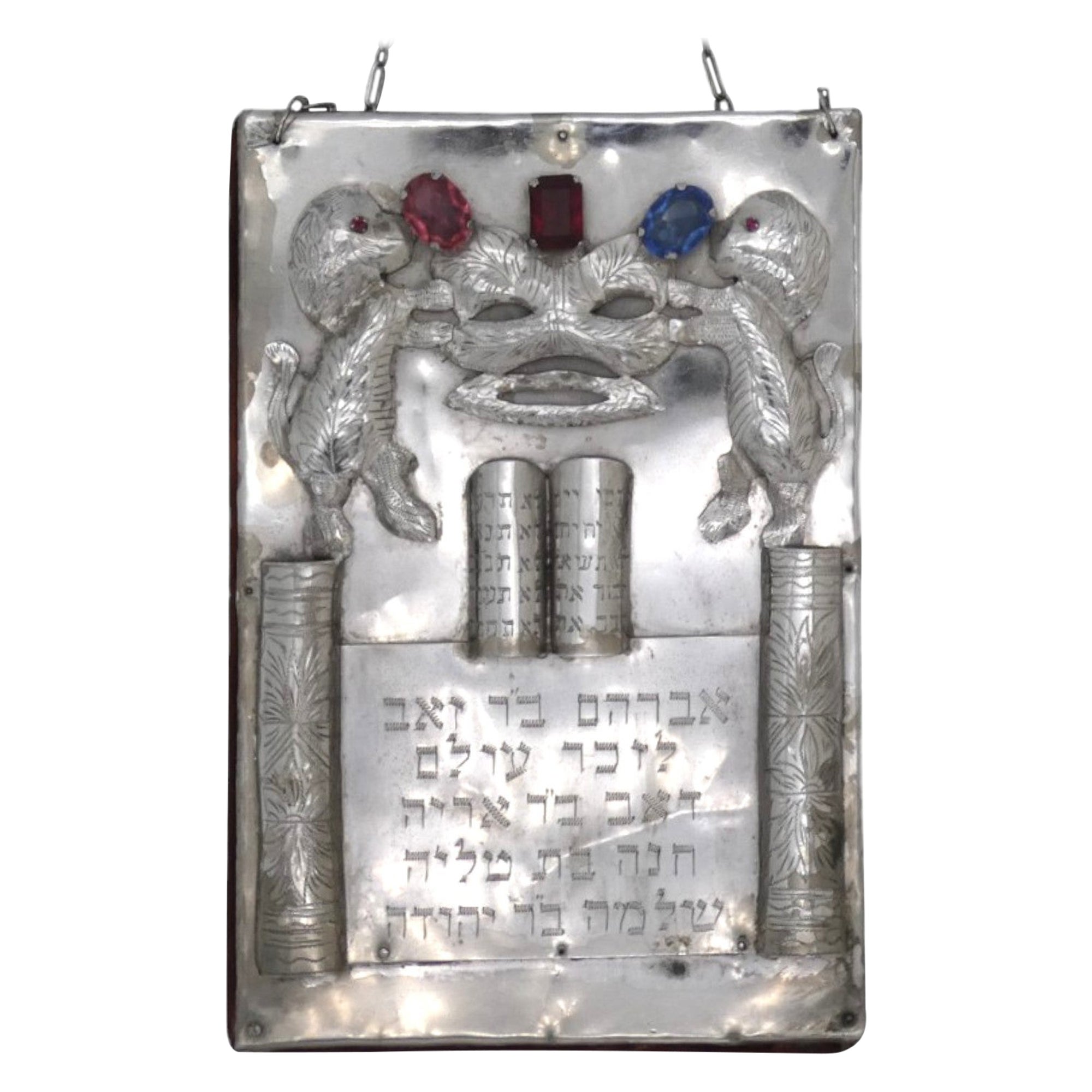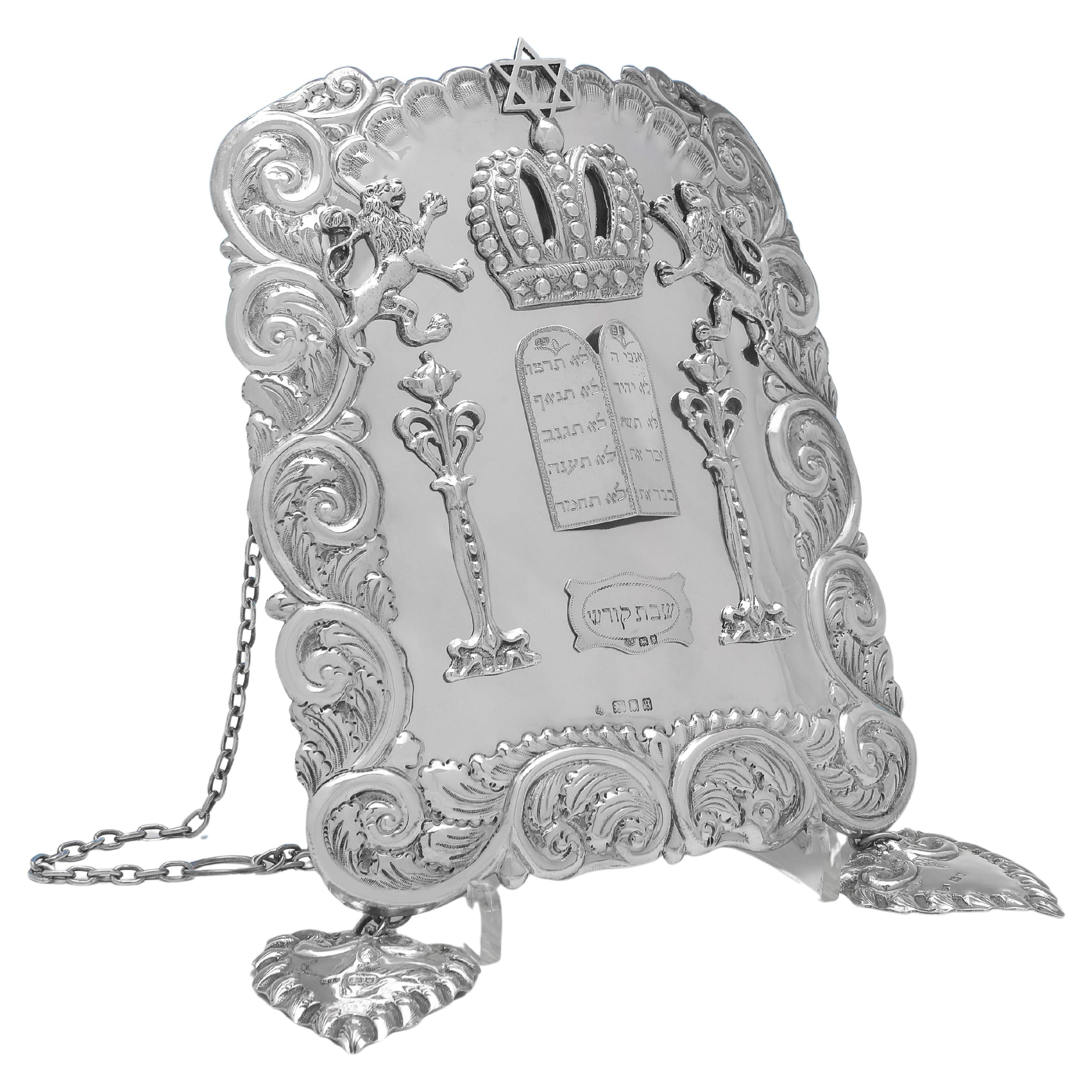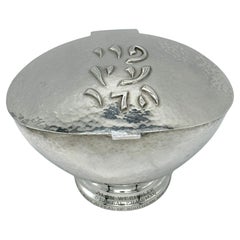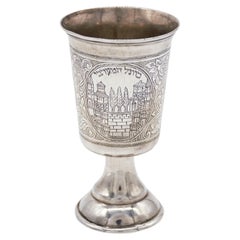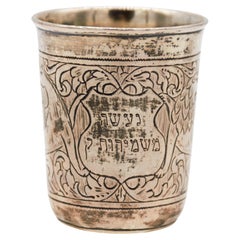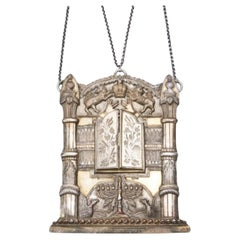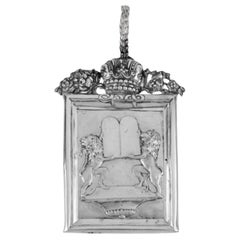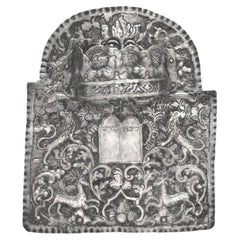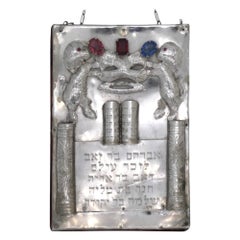Items Similar to Russian silver torah shield, judaica, Michael Karpinsky, Saint Petersburg, 1835
Want more images or videos?
Request additional images or videos from the seller
1 of 15
Russian silver torah shield, judaica, Michael Karpinsky, Saint Petersburg, 1835
$12,000
£9,110.20
€10,420.12
CA$16,765.74
A$18,647.16
CHF 9,736.97
MX$226,916.14
NOK 124,355.95
SEK 116,623.94
DKK 77,769.35
Shipping
Retrieving quote...The 1stDibs Promise:
Authenticity Guarantee,
Money-Back Guarantee,
24-Hour Cancellation
About the Item
Rare and exceptional example of early russian Judaica, this torah shield or tas is made From 84 silver, has the marks of the city of saint Petersburg, together with the makers Mark of Michael Karpinsky and the date of 1835, Judaica objects from Russia is very rare, Especially from this early date, saint Petersburg jewish community was very small Because of the Jewish settlement was largely restricted. Under Tsar Alexander II upper Class Jews fitting certain criteria were allowed to live in the city, and many other Jews Who did not fit these categories settled illegally.
This was is decorated with two flanking lions with the two tablets of stone on which the Ten Commandments were engraved on, the 10 commandments are engraved in Hebrew On this example as long as the two words "torah" and "crown" on the two sides.
On the lower part there is the inscription with the donors name which is "Dina Whitenbarch" in Hebrew. the silver work on this was is just exceptional and deep.
The crown on the top of the lions is the Russian crown.
The back part has two welded silver loops used for hanging the shield on the torah.
Measurements :
Height : 23 cm / 9 inch
Width : 19 cm / 7.4
Jews of saint Petersburg:
The history of the Jews in Saint Petersburg (formerly known as Petrograd and then Leningrad) dates back to the 18th century and there is still a Jewish community in the city Today. In the late 18th century, the annexation of eastern Poland meant millions more Jews were now subjects of the Russian Empire, many of whom flocked to the city. When Catherine the Great created the Pale of Settlement to attempt to contain the new Jewish Population, Jewish settlement was largely restricted. Under Tsar Alexander II upper class Jews fitting certain criteria were allowed to live in the city, and many other Jews who did Not fit these categories settled illegally. By the end of his reign in 1881, the Jewish Population of the city was 17,253. Unlike other cities in the Russian Empire, Saint Petersburg never had a pogrom, likely due to the amount of police and army presence it Had as the capital. The community continued to grow, despite expulsions and Persecution, and flourished creatively until the Bolshevik Revolution.
The Grand Choral Synagogue of Saint Petersburg is the third-largest synagogue in Europe.
Russian silver fineness hallmarking :
The standard of fineness in Russia is usually measured in zolotniks and there are 96 Zolotniks to the russian pound. the most common fineness to be encountered is 84 and This corresponds to 875 parts per 1000 silver, which falls between the most common European standard of 800 and the sterling standard of Britain which is 925/1000.
- Dimensions:Height: 9 in (22.86 cm)Width: 7.4 in (18.8 cm)Depth: 1 in (2.54 cm)
- Style:Neoclassical Revival (Of the Period)
- Materials and Techniques:Silver,Repoussé
- Place of Origin:
- Period:
- Date of Manufacture:1835
- Condition:Wear consistent with age and use. Perfect condition to its age, no brakes, no restorations, Some minor scratches And age related wear. Some bents on the outer borders of the torah shield.
- Seller Location:Tel Aviv - Jaffa, IL
- Reference Number:1stDibs: LU8130235670832
About the Seller
No Reviews Yet
Vetted Professional Seller
Every seller passes strict standards for authenticity and reliability
1stDibs seller since 2023
- ShippingRetrieving quote...Shipping from: Tel Aviv - Jaffa, Israel
- Return Policy
Authenticity Guarantee
In the unlikely event there’s an issue with an item’s authenticity, contact us within 1 year for a full refund. DetailsMoney-Back Guarantee
If your item is not as described, is damaged in transit, or does not arrive, contact us within 7 days for a full refund. Details24-Hour Cancellation
You have a 24-hour grace period in which to reconsider your purchase, with no questions asked.Vetted Professional Sellers
Our world-class sellers must adhere to strict standards for service and quality, maintaining the integrity of our listings.Price-Match Guarantee
If you find that a seller listed the same item for a lower price elsewhere, we’ll match it.Trusted Global Delivery
Our best-in-class carrier network provides specialized shipping options worldwide, including custom delivery.More From This Seller
View Allextremely rare Algerian Judaica silver, jewish Dowry box early 19th century
Located in Tel Aviv - Jaffa, IL
Amazing and scarce JUDAICA object, we have here one of the most touching jewish objects we had for a long time, this small silver dowry box was made in Algeria in the early 19th century, it is all covered with symbols of jewish faith and of couples, the sliding lid has 2 flanking birds with hamsa (protective hand) on each side and a flower vase in the middle.
one side shows two flanking lions with a tree in the middle and the other side shows again two big and two small birds with a flower bowl in the middle, front side has a key hole and next to it there is the Hebrew inscription ס״ט״" which says Siman tov or in English "a good sign" it is taken from the wedding blessing, underneath the lock there is another inscription with the name ״עזיזה בת אברהם בן חמו״ which is the name of the bride, her father and her grandfathers name.
the box is full marked a lot of times with the silversmith mark, every side of the box is marked.
this box was probably ordered by the grooms family to hold the jewelry they are giving to the bride as dowry, this type of objects are rare and there are just a few of them on museum collections.
DOWRY (Heb. נְדֻנְיָה), the property a wife brings to her husband at marriage; the Yiddish equivalent, nadn, is from the same root. The custom of nedunyah became clearly defined and institutionalized only in the talmudic period. In biblical times, mohar (מֹהַר), whereby the groom bought his wife from her father (Gen. 24:53; Ex. 22:15–16; Hos. 3:2), was the accepted practice. It was then customary that the groom give the bride gifts, and that she bring certain property to her husband's home upon marriage: slaves, cattle, real estate, etc. (cf. Gen. 24:59–61; 29; Judg. 1:14ff.; I Kings 9:16). Evidence of the custom of nedunyah is to be found in Tobit (7:14; 8:21) and in the Assuan papyri (Cowley, Aramaic, nos. 15, 18). Gradually, mohar was superseded by the ketubbah custom according to which the husband merely assumed the responsibility of compensation to his wife in case he divorced her: he had to pay her 200 zuzim if she had been a virgin at the time of marriage, and 100 zuzim if a widow or divorcée (see *Ketubbah).
By talmudic times, the institution of nedunyah was prevalent; the father gave a dowry to the bride since the daughter was excluded from paternal inheritance. Fifty zuzim (equivalent to the worth of 180 grams of silver) was the minimum amount a father was obliged to give to his daughter (Ket. 6:5). Parents usually gave much more, according to their social standing. Community funds provided the dowry for an orphan or a very poor girl (ibid.; cf. Sh. Ar., YD 251:8). In case of her father's death, the brothers of a minor girl were obliged to give her the minimum dowry, and the court estimated how much her father would have given her above the minimum dowry. The sum was then taken out of the father's estate and given to the daughter upon majority (Ket. 6:6; 68a–69b). In the absence of such an estimate, each daughter was entitled to receive one-tenth of the value of her father's estate in money, or in valuables (Yad, Ishut, 20:4–7; Sh. Ar., EH 113:4). If the father was unable or unwilling to pay the promised dowry at the betrothal ceremony, the groom could refuse to marry his bride (Ket. 13:5; Ket. 108b–109a). Insistence on exact payment of the promised dowry, however, was frowned upon by later rabbinic authorities (Rema to Sh. Ar., EH 2:1). In certain communities it was customary for the groom's father to make a dowry contribution equal to that of the bride's father (Ket. 102b). The dowry, whether given in real estate, slaves, money, or chattel was recorded in the marriage contract (the ketubbah) and in some instances one-third or one-fifth of the actual value of the dowry was added to the sum mentioned in the ketubbah. Based upon a decree enacted by *Simeon b. Shetah (first century C.E.), the Talmud ruled that the husband and his entire property were liable for compensation as stipulated in the ketubbah, either in case he died (when she collected the sum specified in the ketubbah from the heirs) or in case he divorced his wife (Ket. 82b). For the status of the dowry and the husband's rights and obligations, see below. The rabbinic enactments (Takkanot Shum) by R. Jacob *Tam and by the rabbinic synod of the communities of Speyer, Worms, and Mainz (Germany) stipulated that if a woman died...
Category
Antique Mid-19th Century Algerian Tribal Art
Materials
Silver
JUDAICA SILVER ETROG BOX DESIGNED BY LUDWIG WOLPERT. New York, 20th century
Located in Tel Aviv - Jaffa, IL
This charming piece of jewish history in front of you is a one of kind modern Judaica object,
This box used to hold the Etrog To protect the it during the holiday of Sukkot, it is traditionally Wrapped in silky flax fibers and stored in a special decorative box, mostly made from silver.
Wolpert designed this amazing hand hammered Bauhaus style box in 1963-1964 while he was Working in New York. all of the boxes we could found from this design made by Wolpert have The upper part inscribed in a simple engraving with the phrase "Pri Etz Hadar"
In Hebrew ״פרי עץ הדר״. the box in front of you is the only example in existence as far as we Know where the letters are also repoussé and also engraved, such a beautiful and hard to get Combination, the rest of the box is shaped as a modernistic Etrog, all the body of the box is Skillfully hand hammered in a way it reflects the light in a warm and calm way, a true Masterpiece of modern judaica by the great and important artist Ludwig Yehuda Wolpert.
One of the the two great masters of 20th century Judaica.
the Box is marked "WOLPERT" AND "STERLING" and the base has the engraved inscription :
"ALAN WECHSLER GENERAL CHAIRMAN, ALLIED JEWISH APPEAL OF SOUTHERN NEW JERSEY 1978"
Similar boxes can be find in museum collections around the world
In the Jewish Museum New York
In the North Carolina Museum of Art
In The Derfner Judaica Museum
Another similar box was featured in the Israel Museum exhibition
"Forging Ahead, Wolpert and Gumbel, Israeli Silversmiths for the Modern Age"
Ludwig Yehuda Wolpert was born in Hildesheim, Germany, to an Orthodox family. In 1916-1920, He began his studies in sculpture at the Frankfurt School of Art. In 1925-1928, he studied Goldsmithing at the Frankfurt School of Art.
Following the presentation of the works in the 1930 exhibition "Kult und Form" ("Ritual and Form") at the Jewish Museum in Berlin, his works became well known in the German Jewish World. His works were greatly influenced by Modernist design, especially the Bauhaus Movement. Wolpert's works avoid decoration, relying on clean, geometric shapes. In 1933, Following the Nazi rise to power in Germany, he immigrated to the Mandatory Palestine with His family. There he worked for two years in the workshop of Bernhard Friedländer, where he Designed and produced silverware and Jewish ceremonial art.Together with Victor Solomon...
Category
Vintage 1960s Decorative Boxes
Materials
Silver
Rare "Safed" kiddush cup, late 19th century Poland/ Eretz ISRAEL
Located in Tel Aviv - Jaffa, IL
This 84 silver cup was made in Europe, in Poland or parts of Poland that are in modern Russia in the 19th century, the interesting and important in this cup types is that they were s...
Category
Antique 1890s Israeli Sterling Silver
Materials
Silver
A RARE SILVER SHMIROT KIDDUSH CUP. Galician, c. 1850.
Located in Tel Aviv - Jaffa, IL
A RARE SILVER SHMIROT KIDDUSH CUP. Galician, c. 1850.
Among some Hassidic courts, it was a practice for the Rabbi to give a blessed silver coin to his Hassidim as an amulet. Such protection might be given for all manner of life events, from healing from an illness to success in travel and the amulet was carried on the body of the recipient. This custom was particularly popular among the Ryzhiner Hassidim and these coins were called "Shmirot". To such coins were attributed extraordinary power and value and they were treasured with great care and love.
this cup is marked with polish loth 12 mark which indicate silver content of 75%.
Size :
Height 2.3 inch / 6 cm
Width : 2 inch / 5 cm
After the specific event for which they had originally be given, such a coin or coins were used in the making of other objects, which maintained the special aura of the Rabbi. Such a coin would be melted in other silver with the amuletic valued being spread evenly to all the silver. Then a ritual object would be fashioned by a silversmith and the special nature of the item would be inscribed on it, indicating in one of several ways that this object had been made from "Shmirot". this objects include Kiddish cups, a Havdalah tray, a Shabbat salt holder, a Chanukkah Menorah, a Torah crown etc.
This object is a Kiddish cup fashioned from such silver. On this cup, the inscription indicating Shmirot is found in the abbreviation of the words "made from shmirot k (kodesh)' " (This is the cup of Shmirot). Such cups were used for blessing the wine so that each use renewed the power of protection granted by the Rabbi. This cup was used for the blessing over wine on Shabbat and holidays. Inscription:
the other iconography on the cup is of a lion that represent Through the tribe of Judah, the lion symbol came to represent the blessing, majesty, and even divine protection of the Jews. The lion symbol continued to be used even after the destruction of Jerusalem, the capital of Judah's nation,
and a unicorn or a re'em, also reëm (Hebrew: רְאֵם), is an animal mentioned nine times in the Hebrew Bible It has been translated as "unicorn" in the Latin Vulgate, King James Version, and in some Christian Bible translations as "oryx" (which was accepted as the referent in Modern Hebrew),[citation needed] "wild ox", "wild bull", "buffalo" or "rhinoceros". Rabbi Natan Slifkin has argued that the re'em was an aurochs, as has Isaac Asimov...
Category
Antique 1850s Sterling Silver
Materials
Silver
Important 18th century Persian Jewish silver Amulet for mother and newborn
Located in Tel Aviv - Jaffa, IL
Mysterious Amazing, 18th century silver talismanic amulet, Amulet for mother and Newborn with image of Lilith in the center made by Jews in Persia, the top of the Amulet has an amazi...
Category
Antique 1790s Tribal Art
Materials
Agate, Silver
Early 20th Century Silver Spice Tower by Yehia Yemini, Bezalel School Jerusalem
Located in Tel Aviv - Jaffa, IL
Very rare Bezalel Jerusalem silver filigree spice tower, this amazing spice Tower was Made by Yehia Yemini, who was the best filigree artist in bezal...
Category
Vintage 1920s Israeli Sterling Silver
Materials
Silver
You May Also Like
A Polish Silver Torah Shield by Pogorzelski, Warsaw, 1890
Located in New York, NY
A Gorgeous Polish Silver Torah Shield, made by Pogorzelski in Warsaw, 1890.
19th-century Poland was home to one of the largest populations of Jewish people living in Europe in that...
Category
Antique 1890s Polish Neoclassical Sterling Silver
Materials
Silver
$9,600 Sale Price
20% Off
A Hungarian Silver Torah Shield, Pressburg 18th Century
Located in New York, NY
An Early Hungarian Silver Torah Shield by Johannes Christophoms Stieger, made in Pressburg in the 18th Century.
This early Hungarian Torah shield is a cherished piece of Hungarian J...
Category
Antique 18th Century Hungarian Sterling Silver
Materials
Silver
$6,000 Sale Price
20% Off
An Important Galician Silver Torah Shield (Tas), 18th Century
Located in New York, NY
A rare and richly symbolic example of 18th-century Eastern European Judaica, this Torah shield (tas) originates from Galicia—a historic region encompassing parts of present-day Polan...
Category
Antique 18th Century Polish Sterling Silver
Materials
Silver
An American Arts & Crafts Torah Shield, Circa 1910
Located in New York, NY
This American Arts & Crafts Torah shield from circa 1910, is a unique piece and is rare and valuable, both for its artistic merit and its cultural significance.
The American Arts & ...
Category
Vintage 1910s American Arts and Crafts Religious Items
Materials
Silver Plate
$3,040 Sale Price
20% Off
Sterling Silver Antique Judaica Torah Breast Plate, Late 19th Century
Located in London, GB
Sterling silver antique Judaica Torah breast plate, Late 19th century
Continental, 1882
Height 34cm, width 26cm, depth 5cm
This wonderful piece of...
Category
Antique Late 19th Century European Religious Items
Materials
Silver, Sterling Silver
Antique Sterling Silver Breastplate - Judaica - London 1922 Jacob Rosenzweig
Located in London, London
Hallmarked in London in 1922 by Jacob Rosenzweig, this Antique Sterling Silver Breastplate, is of traditional form, decorated with two Lions of Judah holding a depiction of the Crown...
Category
Vintage 1920s English Religious Items
Materials
Sterling Silver
More Ways To Browse
Russian Crowns
Russian Tsar
Russian Revolution
18th Century Russian Silver
Alexander Shields
Torah Crown
Torah Shield
Sterling Silver Drinking Cups
Tiffany Ladle
Wallace Sterling Silver Patterns
Antique Cake Table
Baby Cups
Cobalt Sterling
Georg Jensen Sterling Coffee Set
Hermes Dining Set
Silver Perfume Bottles
Sterling Flatware Fiddle
Sterling Silver Burner
